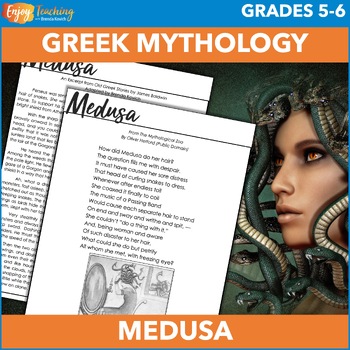Medusa Mythology Activities | Character Description and Point of View
Brenda Kovich
5.8k Followers
Grade Levels
5th - 6th, Homeschool
Subjects
Resource Type
Standards
CCSSRL.5.3
CCSSRL.5.6
CCSSRL.5.9
CCSSRL.6.6
CCSSRL.6.9
Formats Included
- PDF
- Easel Activity
Pages
25 pages
Brenda Kovich
5.8k Followers
Easel Activity Included
This resource includes a ready-to-use interactive activity students can complete on any device. Easel by TPT is free to use! Learn more.
Also included in
- This five-week myth-themed unit will captivate your upper elementary or middle school students. A Greek mythology genre study has been planned for you! It includes a novel study, critical thinking and literature activities, vocabulary, writing, and more!Open the individual previews to get a better lPrice $35.60Original Price $44.50Save $8.90
Description
Who has hair of snakes and eyes that can turn you to stone? Medusa, of course! You can spice up your mythology unit or novel study with these engaging literature activities.
Grab students’ attention with two different views of this alluring mythical creature.
- “Medusa,” a humorous poem told in first person, characterizes the Gorgon as a frustrated woman who just can’t do a thing with her hair.
- Conversely, a brief narrative entitled “The Dreadful Gorgons” provides a third-person account of Perseus’s quest to slay the monstrous Medusa.
A set of five activities engages fifth and sixth grade students in these activities:
Character Description
- Students learn about archetypes.
- They read "Prometheus" and study a sample character description.
- Students read the poem and/or narrative about Medusa and write a thorough character description.
Point of View
- They identify the narrator’s point of view and describe how it influences events in a text.
Character Information
- Students gather information from both texts to fill out an information sheet.
Comparing Viewpoints
- Students compare and contrast the two pieces, analyze how a modern work of fiction draws on character types from myths, and consider how original material is created.
Taking the Opposing Viewpoint
- Each student writes an original third-person narrative to parallel “The Dreadful Gorgons” but portrays Medusa in a favorable light.
Open the preview to take a closer look.
Enjoy Teaching!
Brenda Kovich
Total Pages
25 pages
Answer Key
Included with rubric
Teaching Duration
1 Week
Report this resource to TPT
Reported resources will be reviewed by our team. Report this resource to let us know if this resource violates TPT’s content guidelines.
Standards
to see state-specific standards (only available in the US).
CCSSRL.5.3
Compare and contrast two or more characters, settings, or events in a story or drama, drawing on specific details in the text (e.g., how characters interact).
CCSSRL.5.6
Describe how a narrator’s or speaker’s point of view influences how events are described.
CCSSRL.5.9
Compare and contrast stories in the same genre (e.g., mysteries and adventure stories) on their approaches to similar themes and topics.
CCSSRL.6.6
Explain how an author develops the point of view of the narrator or speaker in a text.
CCSSRL.6.9
Compare and contrast texts in different forms or genres (e.g., stories and poems; historical novels and fantasy stories) in terms of their approaches to similar themes and topics.







